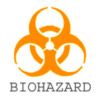
Biological/regulated medical waste is generated in diagnosis, treatment and immunization of humans or animals, in research pertaining thereto, or in production and testing of biologicals. Biological waste may include animal waste, cultures and stocks, human blood, blood products, tissues, cell lines and body fluids, human pathological waste, recombinant DNA, infectious agents, isolation waste and sharps. A summary of biological waste disposal procedures are provided below, and the entirety of the ![]() waste disposal procedures are available on the EHS website.
waste disposal procedures are available on the EHS website.
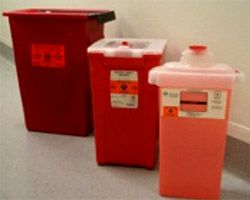
Sharps Waste
Sharps waste includes any glass, metal, or plastic instruments or items that have the potential to cut, puncture, scratch, or abrade skin, whether it is biological contaminated or not. Sharps include but are not limited to:
- hypodermic, intravenous or other medical needles
- scalpel blades and razor blades
- Pasteur pipettes and serological pipettes
- blood vials
Collections
1300 York Avenue, Oxford Building, S-building, and other main campus locations (excluding Weill Greenberg Center): Sharps are collected weekly via the Sharps Collection Request.
Weill Greenberg Center: Sharps are collected every Tuesday.
RR Building and NYBC: Sharps are collected monthly.
Offsite clinical locations: Contact EHS to set up sharps disposal services.
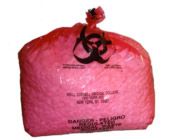
Red Bags
Utilize red bags for solid, non-sharps wastes and small (<10ml) vials with sealed caps (e.g., eppendorf tubes or cryovials).
Collections
To request additional red bags for areas serviced by WCMC Housekeeping, please call (646) 962-9912.
Red bags are collected nightly by WCMC Environmental Services, who provide housekeeping services.
Offsite clinical locations: Contact EHS to set up red bag disposal services.
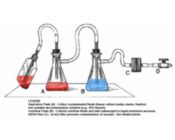
Tissue Culture and Other Biological Waste Liquids
Tissue culture and other biological waste liquids must be properly disinfected and assessed for chemical and radiological hazards prior to disposal.
Chemotherapeutic Waste
Chemotherapeutic agents are highly toxic agents. All related wastes, including bottles, vials, syringes, IV-bags, etc. must be properly segregated, managed, and disposed. Contact EHS to evaluate the proper management and disposal of chemotherapeutic agents. Additional training may be required.
Animal Tissues and Pathological Wastes
Vertebrate animal tissues and carcasses should be disposed through the Research Animal Resources Center (RARC). It is important to adhere to the procedures specified by RARC and approved by AAALAC.
Invertebrate animal tissues and carcasses not administered through the RARC must be disposed via standard red bags or sharps bags (if contained in sharp-like containers).
Human Pathological Waste
Recognizable human tissues, organs and body parts are regulated under various state laws regarding the proper disposal of human remains. Each case will be considered individually. Contact EHS to determine the appropriate means for disposing of human pathological waste.
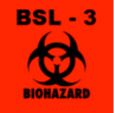
Select Agents and Biosafety Level 3 Waste
Select Agents and Biosafety Level 3 waste must be disposed as specified in the Select Agent and Biosafety Level 3 manuals. Contact EHS for assistance or additional information.

